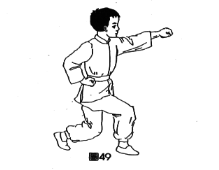Headhunter
Senior Master
The better question is are you ever going to make a thread that isn’t you talking crap about something a style does?
Follow along with the video below to see how to install our site as a web app on your home screen.
Note: This feature may not be available in some browsers.
If the form creator didn't include "dynamic punch" in his created form, to coordinate punch with leading foot landing cannot be trained.
The moment that you concentrate on how to coordinate your punch with your leading foot landing, the moment that you will take your mind away from your back foot ground connection. Your back foot then will slide along the ground when your body is moving forward.
So to switch from
- coordinate punch with back leg straight to,
- coordinate punch with leading foot landing,
is the critical training progress.
The tsuki thrown in Karate Kata is not a striking technique.Jumping rope is not a striking technique
The issue is if one skips the static punch training, he won't be able to understand power generation - borrow counter force from the ground.Why would he not intend dynamic punching in a system created for self defense? And btw, in boxing, you do have the rear foot lifted regardless if you're shadow boxing or sparring. The rear foot is never planted on impact unless you punch moving backwards
Do you know any Karate form that has the dynamic punch - front foot hop forward, back foot slide?
You can only coordinate your punch with yourBut that’s irrelevant. There is no drawback to have the rear foot lifted on impact even if you train static punching. It does not undermine your form. The only difference is that you are doing forms of punching in a logical way...
You can only coordinate your punch with your
1. back leg straight, or
2. leading foot landing.
You can't do both on the same punch. For each and every punch that you have in your form, you can do some punches as static punch, and do some punches as dynamic punch.
Why even get involved?
When you move forward, you can't advance your leading foot without advance your back foot. When your back foot is also advanced, your back foot cannot connect on the ground.Let's stick to moving forward tsukis. You can move forward in a kata and keep the rear foot up on impact , or you can put it down.
Let me ask you this simple question.
Do you coordinate your punch with your
1. back leg straight (the moment that your back leg move from bend to straight, the moment your punch land), or
2. leading foot landing (the moment your front foot lands on the ground, the moment your punch land)?
You can move to whatever extent is needed, and then root for the brief duration of the punch. And then move some more. It’s about doing what you need to do, when you need to do it. Adapting to what is needed and what is appropriate.You can only coordinate your punch with your
1. back leg straight, or
2. leading foot landing.
You can't do both on the same punch. For each and every punch that you have in your form, you can do some punches as static punch, and do some punches as dynamic punch.
Do you know whether the dynamic punch is in Karate form training or not?
You can move to whatever extent is needed, and then root for the brief duration of the punch. And then move some more. It’s about doing what you need to do, when you need to do it. Adapting to what is needed and what is appropriate.
But, rooting the heel down and using that brace against the ground to rotate the torso is definitely a good way to deliver a very powerful punch. You do that when you need to kill or injure someone. I assume that in sparring you don’t want to kill or injure someone. Sparring is a friendly interaction, even when done “full contact”. So you apply it differently. Sparring is not the yardstick with which to measure all things.
After you have borrowed the counter force from the ground, your power has been generated through your back leg, to your hip, body, shoulder, arm, .... you no longer need your back foot to connect on the ground. You can raise your leg up in golden rooster stance if you want to (if that can let you to have the maximum reach).I don't comprehend that dichotomy. How does having the supporting leg planted as opposed to lifted affect whether you are a doing a static punch or not? You are still moving forward and extending an arm.
After you have borrowed the counter force from the ground, your power has been generated through your back leg, to your hip, body, shoulder, arm, .... you no longer need your back foot to connect on the ground. You can raise your leg up in golden rooster stance if you want to (if that can let you to have maximum reach).
Lifting the rear leg and leaning forward has been shown to create a 100% less effective arm bar take down. Also makes a very less effective push.Lifting the rear leg and leaning forward was shown to create a 30% more powerful punch.
I disagree with that 30% assessment.Lifting the rear leg and leaning forward was shown to create a 30% more powerful punch. But I guess the 30% less powerful punch is more deadly.
Lifting the rear leg and leaning forward has been shown to create a 100% less effective arm bar take down. Also makes a very less effective push.
If you are only concerned with punching... study boxing.
In one sparring, my punch was still far away from my opponent's face. I raised up my back foot (change from bow-arrow stance into golden rooster stance), my fist still could not reach to my opponent's face. I landed my back foot behind my leading foot (change from golden rooster stance into stealing step), my fist finally landed on my opponent's face.So... Why doesn't anybody punch that way when they free spar? You wrote yourself that it's more geared towards beginners


In one sparring, my punch is still far away from my opponent's face. I raise up my back foot (change from bow-arrow stance into golden rooster stance), my fist still could not reach to my opponent's face. I land my back foot behind my leading foot (change from golden rooster stance into stealing step), my fist finally landed on my opponent's face.
Whether you keep your back foot on the ground, slide, raise it up, or land forward, it all depends on the distance that you intend to reach. That's why we train so many different stances. Each stance can give you different reach distance.
If I don't need to move my back foot, I want my back foot to connect to the ground. That can give me the strongest body structure. That can help me to generate the maximum power.Even close range, it's illogical throwing a right hand with the rear foot planted. You won't do that naturally.

